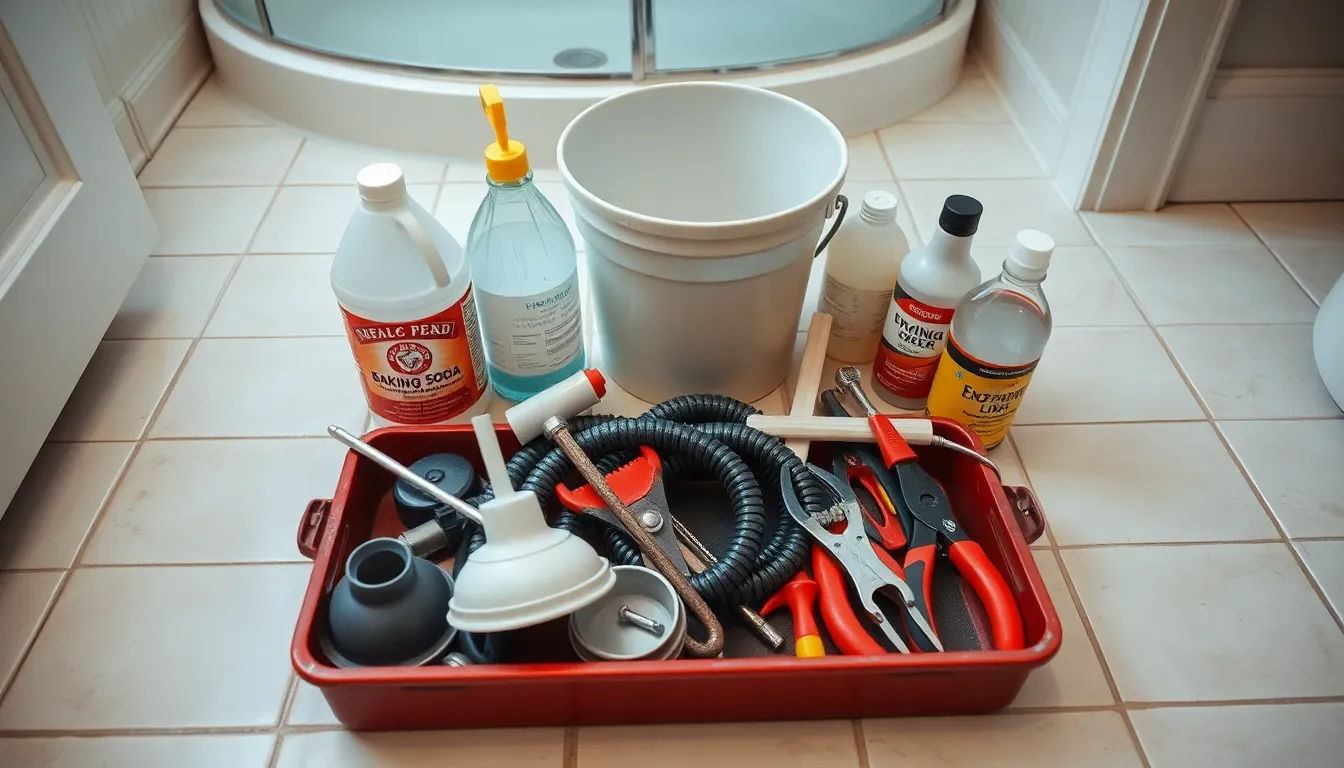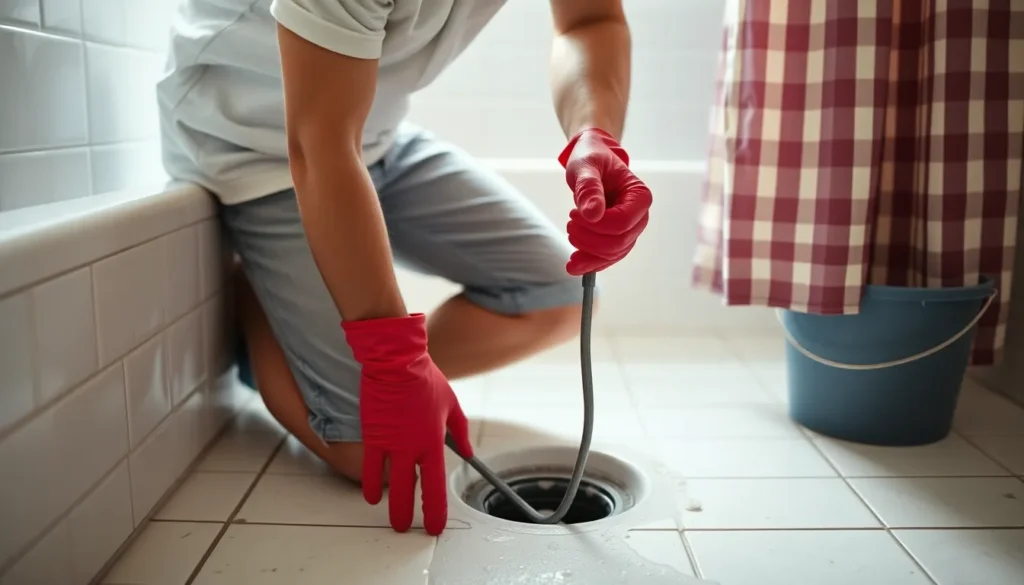Table of Contents
ToggleA clogged shower drain can turn a relaxing soak into a mini swimming pool disaster. Nothing’s worse than standing in a puddle of soapy water while trying to rinse off after a long day. It’s like your shower’s way of saying, “Not today, my friend!” But fear not; fixing that pesky drain doesn’t require a superhero cape or a degree in plumbing.
Overview of Clogged Shower Drains
Clogged shower drains can disrupt the shower experience, leading to water pooling in the tub. Understanding the causes and signs of clogged drains helps in effective troubleshooting and prevention.
Common Causes of Clogs
Hair buildup often leads to clogs, as strands accumulate over time and create blockages. Soap scum also plays a significant role, forming residue that traps dirt and hair. Further, mineral deposits from hard water can solidify and narrow the drain pipe, causing slow drainage. Objects like small shampoos or toys dropped into the drain contribute to obstructions as well. Regular maintenance can reduce the frequency of these issues.
Signs of a Clogged Shower Drain
Pooling water at the shower’s base indicates a potential clog. Slow drainage during or after a shower signals a blockage forming within the pipes. Unpleasant odors may arise due to decomposition of trapped debris, hinting at a problem below. Additionally, gurgling sounds during drainage can signify air trapped in the pipes, resulting from a blockage. Recognizing these signs early can prevent larger issues down the line.
Tools and Materials Needed

Gathering the right tools and materials simplifies the process of fixing a clogged shower drain. Preparation enhances efficiency and effectiveness during the repair.
Essential Tools
- Plunger – A standard cup plunger works well for most shower drains.
- Drain Snake – A manual or rotary drain snake effectively removes hair and debris.
- Pliers – Use pliers to grip and remove items that may be deep in the drain.
- Screwdriver – A screwdriver is needed for removing the drain cover, if applicable.
- Bucket – Keep a bucket handy to collect debris and water while cleaning.
Recommended Cleaning Solutions
- Baking Soda and Vinegar – This combination breaks down organic materials and neutralizes odors.
- Enzymatic Cleaners – Designed to dissolve hair and soap scum, these cleaners are environmentally friendly.
- Chemical Drain Cleaners – Strong acids work quickly but should be used carefully, as they can damage pipes.
- Boiling Water – Pouring boiling water down the drain helps to dissolve grease and soap buildup.
- Salt and Baking Soda Mix – Combining these ingredients creates a strong cleaning solution that effectively unclogs drains.
Step-by-Step Guide to Fixing a Clogged Shower Drain
Fixing a clogged shower drain involves a systematic approach. Following specific steps ensures effective resolution of the problem without unnecessary complications.
Initial Assessment and Safety Precautions
Begin by assessing the situation. Check for visible debris around the drain and observe any signs of slower drainage or unpleasant odors. Next, ensure safety by wearing rubber gloves and goggles. Water pooling can create slippery surfaces, so use towels to absorb extra liquid. If using a chemical cleaner, make sure the bathroom is well-ventilated. Ensuring these precautions creates a safer workspace.
Manual Removal of Debris
Start the manual removal process by removing the drain cover. Use a screwdriver to lift the cover if necessary. Once exposed, inspect the drain for hair, soap buildup, or other clogs. Grab a pair of pliers to remove larger objects. For smaller debris, fingers can often be sufficient. Clearing visible obstructions leads to improved water flow and prepares the drain for further cleaning.
Using a Plumber’s Snake
Utilize a plumber’s snake for deeper clogs. Insert the snake into the drain, twisting and pushing it gently until resistance is felt. This tool reaches further into the plumbing, pulling out stubborn blockages. Continue maneuvering the snake until it feels free; this indicates that the obstruction is broken up. Pull out any debris caught on the snake’s end for a cleaner drain.
Chemical Solutions for Tough Clogs
Consider chemical solutions for persistent blockages. Various commercial drain cleaners are available that target tough clogs effectively. Follow the manufacturer’s instructions for safe and effective use. An alternative involves using a mixture of baking soda and vinegar; this natural option creates a fizzy reaction that helps break down debris. Allow the solution to sit for at least 30 minutes, then flush with hot water for best results. Using chemicals combined with other methods maximizes the likelihood of restoring drainage.
Preventative Measures
Clogged shower drains are often preventable. Implementing routine care keeps drains clear and functional.
Regular Maintenance Tips
Check drains regularly for hair and soap buildup. Clean the drain cover and remove any visible debris weekly. Pour boiling water down the drain monthly to dissolve soap scum and mineral deposits. Consider using a hair catcher to prevent clogs from hair accumulation. Schedule professional inspections annually to address any potential issues before they worsen.
What Not to Put Down the Drain
Avoid rinsing food particles from dishes down the drain. Dispose of grease and oil in the trash to prevent buildup. Don’t let hair, cotton balls, or personal hygiene items wash down. Medication disposal should always follow local regulations and not go down the sink. Using common sense when rinsing products helps maintain a clear shower drain.
Dealing with a clogged shower drain can be a hassle but it’s a problem that can be resolved with the right approach. By understanding the common causes and signs of clogs, individuals can act quickly to prevent further issues. Utilizing the proper tools and cleaning solutions makes the repair process straightforward and efficient.
Regular maintenance and smart practices can significantly reduce the likelihood of future clogs. By taking proactive measures like using hair catchers and performing routine cleanings, maintaining a clear drain becomes much easier. With these strategies in place, shower drains can remain functional and free from unwanted blockages.







